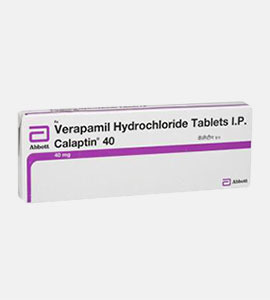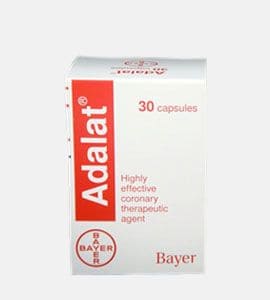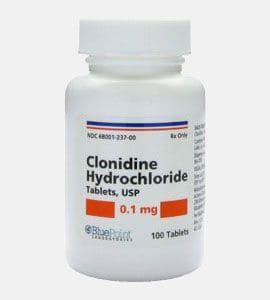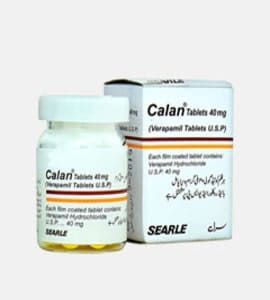What is Aldactone and What is it Used For?
Aldactone contains the active ingredient spironolactone. It is a potassium-sparing diuretic that increases urine production, helping to remove excess fluid from the body. It also lowers blood pressure. Aldactone is used to treat fluid retention (edema) and high blood pressure when other treatments are ineffective or inadequate. It is also used for primary aldosteronism when other therapies are insufficient or inappropriate. Children should be treated by a pediatrician.
Before Using Aldactone
Do not use Aldactone if you:
- Are allergic to spironolactone or any other ingredient in the medication
- Have acute kidney failure, significantly reduced kidney function, or no urine production
- Have Addison's disease (reduced hormone production)
- Have elevated potassium levels in the blood
Children with moderate to severe kidney disease should not use Aldactone.
Warnings and Precautions
Consult your doctor or pharmacist before using Aldactone if you:
- Suffer from severe heart failure
- Are older and/or have impaired kidney or liver function
- Have kidney disease, particularly if you have high blood pressure, or liver disease
Routine blood tests may be needed to monitor potassium, sodium, and/or urea levels in your blood.
Using Aldactone with certain medications, potassium supplements, or high-potassium foods can lead to severe hyperkalemia. Symptoms may include muscle cramps, irregular heartbeat, diarrhea, nausea, dizziness, or headache.
In rare cases, Aldactone can affect white blood cells, potentially impairing the immune system. If you experience symptoms like fever with severe discomfort or localized infections, seek medical attention promptly.
Drug Interactions
Inform your doctor or pharmacist if you use, have recently used, or might use other medications. Aldactone’s effects may be altered by:
- Potassium-containing medications or high-potassium diets
- NSAIDs (for pain and inflammation)
- ACE inhibitors, angiotensin II antagonists, aldosterone antagonists, digoxin
- Other potassium-sparing diuretics
- Norepinephrine (used in anesthesia)
- Ammonium chloride (used for high body pH)
- Cholestyramine (used for high cholesterol)
- Carbenoxolone (used for esophageal conditions)
- Heparin (blood thinner)
- Tacrolimus (used after transplantation)
- Trimethoprim and trimethoprim-sulfamethoxazole
Aldactone may affect some laboratory tests. Consult your doctor before using other medications, including supplements.
Aldactone with Food, Drink, and Alcohol
Take the tablets with food. Avoid alcohol as it may enhance side effects. Do not use salt substitutes or low-sodium products containing potassium.
Pregnancy, Breastfeeding, and Fertility
If you are pregnant, breastfeeding, think you might be pregnant, or plan to become pregnant, consult your doctor or pharmacist before using this medication.
Spironolactone has limited data on use during pregnancy and can pass into breast milk. There is no clinical data on its effect on fertility in humans, though animal studies show reduced fertility in females.
Driving and Using Machines
Some patients may experience dizziness or drowsiness, especially at the start of treatment. Be cautious when driving or operating machinery.
How to Use Aldactone
Always follow your doctor’s or pharmacist’s instructions. The usual dose for adults is 50-100 mg daily, taken with food. The dose may be adjusted as needed. It may take some time for the treatment to take effect, so do not stop or change the dose without consulting your doctor.
Aldactone can be used in children, with the dose adjusted based on the child’s weight.
Common Uses
Aldactone is a magnesium and potassium-sparing diuretic and aldosterone antagonist. It helps increase the excretion of sodium while decreasing potassium and magnesium loss. The diuretic effect usually appears after 2-5 days of treatment and lasts for 2-3 days after stopping. It is used in combination with other medications to treat hypertension and to remove excess fluid from the body in conditions like congestive heart failure, liver cirrhosis, and kidney disease.
Dosage and Directions
The typical dose for adults with hypertension or edema is 50-100 mg daily, divided into 1-2 doses. It may be increased to 200 mg daily if necessary. The treatment duration should be at least two weeks. Consult your doctor for specific dosages for conditions like chronic heart failure, cirrhosis, or nephrotic syndrome. Take Aldactone after a meal, preferably in a single dose before bedtime.
Precautions
Avoid excessive salt intake and do not use potassium substitutes. Consult your doctor about fluid intake and avoid overheating or dehydration during exercise. Do not stop the medication even if you feel better, especially if being treated for high blood pressure.
Contraindications
Do not use Aldactone if you have hypersensitivity, Addison’s disease, hypercalcemia, hyperkalemia, or if you are taking potassium supplements or other potassium-sparing diuretics. It should also be avoided in cases of chronic kidney failure, diabetic nephropathy, anuria, liver failure, pregnancy, and other specified conditions. Use only as advised by your doctor.
Possible Side Effects
Possible side effects include headache, diarrhea, cramps, drowsiness, rash, nausea, vomiting, impotence, irregular menstrual periods, and abnormal hair growth. Fluid and electrolyte imbalances may occur, so monitor carefully. Breast enlargement may occur depending on dose and duration, but usually reverses upon discontinuation.
Drug Interactions
Aldactone can lower blood sodium levels and raise potassium levels, potentially causing life-threatening heart rhythm abnormalities. It should not be administered with other agents that raise potassium levels or drugs that can elevate digoxin levels to toxic levels.
Missed Dose
Do not take a double dose. If it is almost time for your next dose, skip the missed dose and continue with your regular schedule.
Overdose
If an overdose occurs, seek immediate medical attention. Symptoms may include drowsiness, confusion, rash, nausea, vomiting, or diarrhea.
Storage
Store Aldactone at room temperature, below 25°C (77°F).
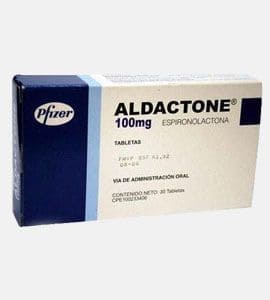

 Deutsch
Deutsch
 English
English
 Español
Español
 Italiano
Italiano
 Čeština
Čeština
 Français
Français
 العربية
العربية
 CHF
CHF


